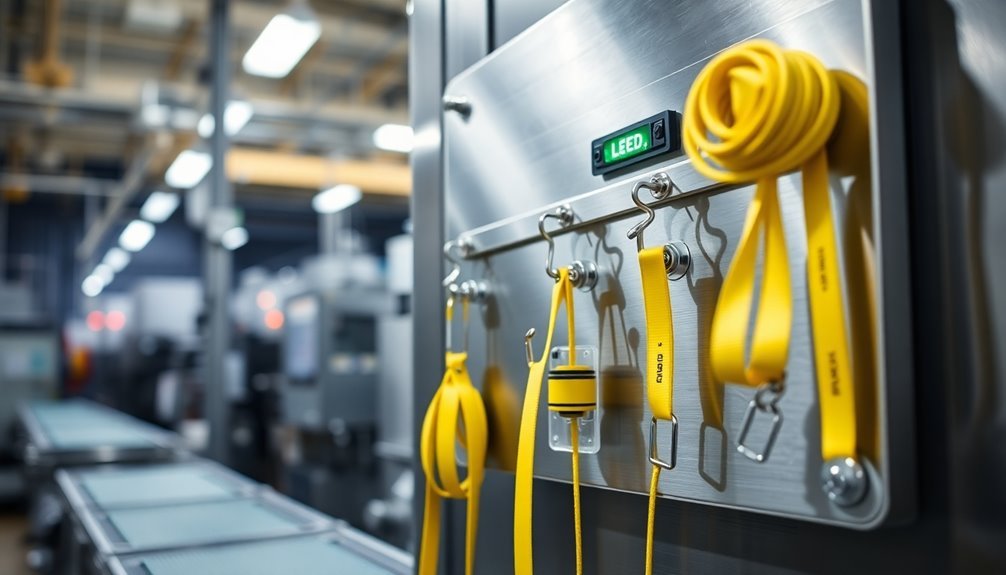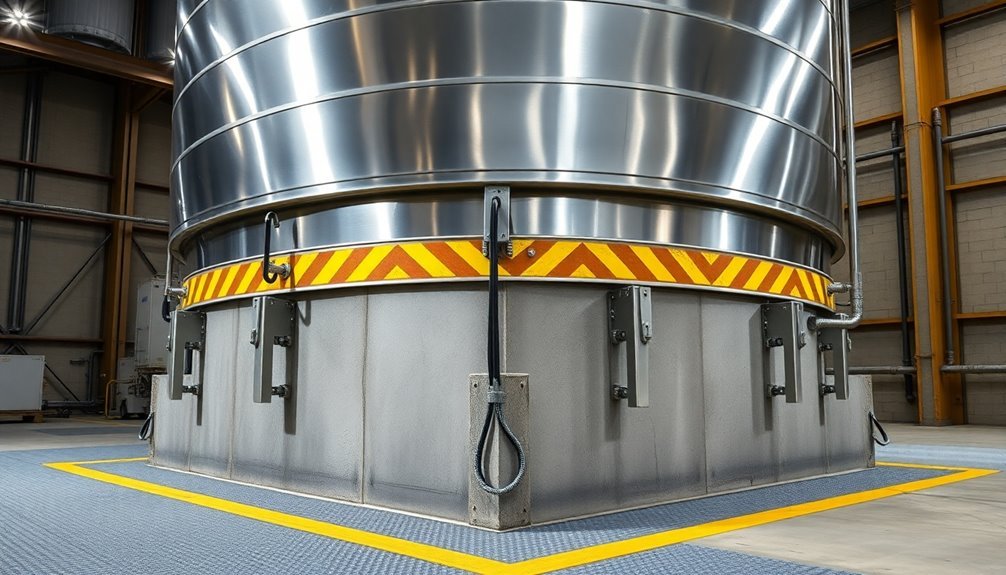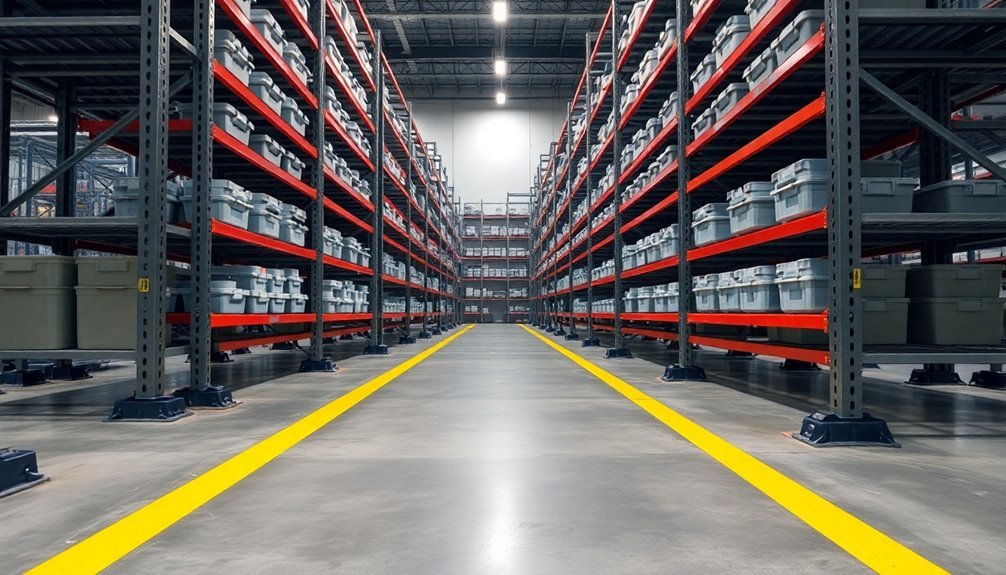Three essential grounded storage solutions will help protect your production line's safety: operator grounding equipment, static dissipative storage systems, and properly secured silos. You'll need to implement copper conductors and regular testing for operator grounding, while static dissipative systems require ESD-safe bins and conductive surfaces. For silo storage, you'll want proper ladders, ventilation, and strict confined space protocols. These solutions work together to prevent electrical hazards, control static discharge, and maintain worker safety. Discover how these integrated approaches can transform your facility's safety standards.
Operator Grounding Equipment

Proper grounding forms the backbone of operator safety in production environments. You'll need to guarantee your operators have access to essential grounding equipment, including copper conductors and properly installed grounding electrodes. Ground fault protection helps maintain consistent voltage levels across your production line equipment.
When setting up operator stations, you must identify the specific grounding requirements outlined by equipment manufacturers and locate ideal grounding points on metal surfaces.
Your grounding installation process should follow a systematic approach. Start by selecting appropriate copper conductors that match your equipment specifications, then connect them to buried grounding electrodes that maintain sufficient soil contact.
You'll need to equip your operators with proper PPE, including rubber gloves, safety glasses, and flame-resistant clothing, while implementing regular inspection schedules for both grounding equipment and protective gear.
To maintain OSHA compliance (29 CFR 1910.269), you must train your operators on proper grounding techniques and safety protocols. Consider implementing digital monitoring solutions to verify grounding procedures in real-time.
Don't forget to conduct regular audits and maintain detailed documentation of your training records and safety protocols. This thorough approach guarantees your operators remain protected while working with electrical equipment on your production line.
Static Dissipative Storage Systems
Building on your operator grounding protocols, static dissipative storage systems form another critical layer of protection in your production line safety strategy. You'll need to integrate key components like antistatic poly materials, conductive paint, and dissipative coatings throughout your storage areas. Implementation requires ESD-safe bins, grounded shelving, and properly marked workstations. ESD-safe floor liners are essential for ensuring complete grounding coverage in storage zones.
| Impact Area | Without Protection | With Static Dissipative Storage |
|---|---|---|
| Product Quality | High defect rates | 99% reduction in ESD damage |
| Cost Management | Frequent replacements | Long-term savings |
| Production Flow | Frequent disruptions | Smooth operations |
| Compliance | Risk of violations | Industry standard adherence |
To maximize your system's effectiveness, you'll want to focus on proper implementation strategies. Start by installing ESD-safe storage bins throughout your production line and guarantee all shelves are properly grounded. Don't forget to use drag chains instead of dissipative wheels on your carts for better static control. Regular monitoring of static levels and prompt maintenance of storage areas will help maintain a controlled ESD environment. Train your personnel thoroughly on handling procedures and maintain strict cleanliness standards to prevent dust accumulation, which can contribute to static buildup.
Silo Safety Protocols

Silos present unique safety challenges that demand thorough protocols for protection. You'll need to implement detailed safety measures starting with proper site selection and regular maintenance of your storage structures.
Make certain your silos have accessible ladders that terminate seven feet above ground level and display clear warning signs about potential hazards. Carbon dioxide and NO₂ can accumulate in silos and pose lethal risks to workers.
Before any worker enters a silo, you must establish strict confined space entry procedures. Set up a competent administrator to oversee these operations and maintain proper ventilation systems.
Your workers should never enter without safety ropes and harnesses, and you'll need at least two people stationed outside for emergency assistance.
When loading or unloading, don't allow workers to walk on grain surfaces due to dangerous suction risks. Instead, utilize a boatswain's chair with a lifeline for any necessary grain-level work.
You'll need to develop standard operating procedures that minimize dust accumulation and identify potential fire hazards before operations begin.
Remember to maintain updated worker training programs and make certain all personal protective equipment is readily available. Install RCDs for electrical safety and keep workers clear of overhead power lines during maintenance operations.
Frequently Asked Questions
How Often Should Esd-Safe Equipment and Grounding Systems Be Tested for Effectiveness?
You'll need to test your ESD-safe equipment daily for wrist straps, quarterly for worksurfaces, and semi-annually for continuous monitors. Don't forget to check grounding systems after any maintenance or facility changes.
What Temperature and Humidity Levels Are Optimal for Preventing Static Buildup?
You'll need to maintain humidity above 55% RH and keep temperatures stable to prevent static buildup effectively. For best results, aim to keep your relative humidity between 40-60%, with levels above 55% being most effective.
Can Wireless Inventory Tracking Systems Interfere With ESD Protection Measures?
Yes, you'll find that wireless systems can seriously disrupt your ESD protection measures through static build-up, electromagnetic interference, and uncontrolled charges. They can compromise grounding equipment and increase your risk of ESD events.
What Cleaning Products Are Safe to Use on Esd-Protected Storage Surfaces?
You'll need ESD-specific cleaners like Staticide Mat Cleaner or ICSC-16-ESD that are free from alkalis and ammonia. Use these with microfiber cloths, avoiding excess moisture to maintain your storage surface's static-dissipative properties.
How Do Different Flooring Materials Affect Overall Grounding System Performance?
Your flooring choice directly impacts grounding performance. Conductive tiles offer consistent conductivity, static-dissipative carpeting provides moderate protection, and epoxy coatings deliver durable coverage. Each requires proper installation for maximum effectiveness.
In Summary
You'll substantially reduce workplace hazards by implementing these three grounding solutions in your production facility. Proper operator grounding equipment, static dissipative storage systems, and strict silo safety protocols work together to protect both your employees and materials. Don't wait for an incident to occur – make these essential safety measures part of your daily operations and maintain regular compliance checks.





Leave a Reply